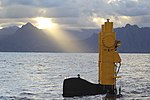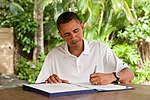Marine Corps Air Station Kaneohe Bay
1939 establishments in HawaiiAirports in HawaiiBuildings and structures in Honolulu County, HawaiiForts on the National Register of Historic Places in HawaiiHistoric American Buildings Survey in Hawaii ... and 8 more
Historic districts on the National Register of Historic Places in HawaiiMilitary airbases established in 1939Military facilities in HawaiiNational Historic Landmarks in HawaiiNational Register of Historic Places in Honolulu County, HawaiiTransportation in Honolulu County, HawaiiUnited States Marine Corps air stationsWorld War II on the National Register of Historic Places in Hawaii

Marine Corps Air Station Kaneohe Bay or MCAS Kaneohe Bay (IATA: NGF, ICAO: PHNG, FAA LID: NGF) is a United States Marine Corps (USMC) airfield located within the Marine Corps Base Hawaii complex, formerly known as Marine Corps Air Facility (MCAF) Kaneohe Bay or Naval Air Station (NAS) Kaneohe Bay. It is located two miles (3 km) northeast of the central business district of Kaneohe, in Honolulu County, Hawaii, United States. The airfield has one runway (4/22) with a 7,771 x 200 ft (2,369 x 61 m) asphalt surface.
Excerpt from the Wikipedia article Marine Corps Air Station Kaneohe Bay (License: CC BY-SA 3.0, Authors, Images).Marine Corps Air Station Kaneohe Bay
Perimeter Road, Kailua
Geographical coordinates (GPS) Address Nearby Places Show on map
Geographical coordinates (GPS)
| Latitude | Longitude |
|---|---|
| N 21.445833333333 ° | E -157.76972222222 ° |
Address
Perimeter Road
96863 Kailua
Hawaii, United States
Open on Google Maps






